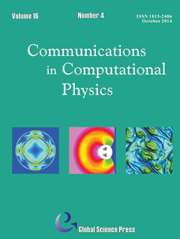Crossref Citations
This article has been cited by the following publications. This list is generated based on data provided by
Crossref.
Naseri, Alireza
Lehmkuhl, Oriol
Gonzalez, Ignacio
Bartrons, Eduard
Pérez-Segarra, Carlos David
and
Oliva, Assensi
2018.
A semi-implicit coupling technique for fluid–structure interaction problems with strong added-mass effect.
Journal of Fluids and Structures,
Vol. 80,
Issue. ,
p.
94.
He, Tao
Zhang, Hexin
and
Zhang, Kai
2018.
A smoothed finite element approach for computational fluid dynamics: applications to incompressible flows and fluid–structure interaction.
Computational Mechanics,
Vol. 62,
Issue. 5,
p.
1037.
Liao, Shaokai
Zhang, Yan
and
Chen, Da
2019.
A Galerkin finite element algorithm based on third‐order Runge‐Kutta temporal discretization along the uniform streamline for unsteady incompressible flows.
International Journal for Numerical Methods in Fluids,
Vol. 90,
Issue. 7,
p.
323.
Naseri, Alireza
Gonzalez, Ignacio
Amani, Ahmad
Pérez-Segarra, Carlos David
and
Oliva, Assensi
2019.
A second-order time accurate semi-implicit method for fluid–structure interaction problems.
Journal of Fluids and Structures,
Vol. 86,
Issue. ,
p.
135.
Liu, Mingyang
Gao, Guangjun
Zhu, Huifen
and
Jiang, Chen
2021.
A cell-based smoothed finite element method stabilized by implicit SUPG/SPGP/Fractional step method for incompressible flow.
Engineering Analysis with Boundary Elements,
Vol. 124,
Issue. ,
p.
194.
Liu, Mingyang
Gao, Guangjun
Zhu, Huifen
Jiang, Chen
and
Liu, Guirong
2021.
A cell-based smoothed finite element method (CS-FEM) for three-dimensional incompressible laminar flows using mixed wedge-hexahedral element.
Engineering Analysis with Boundary Elements,
Vol. 133,
Issue. ,
p.
269.
Akbay, Muzaffer
Schroeder, Craig
and
Shinar, Tamar
2021.
Boundary pressure projection for partitioned solution of fluid-structure interaction with incompressible Dirichlet fluid domains.
Journal of Computational Physics,
Vol. 425,
Issue. ,
p.
109894.
Liu, Mingyang
Gao, Guangjun
Zhu, Huifen
and
Jiang, Chen
2022.
A cell-based smoothed finite element method for incompressible turbulent flows.
International Journal of Numerical Methods for Heat & Fluid Flow,
Vol. 32,
Issue. 2,
p.
531.
Ha, Sang Truong
and
Choi, Hyoung Gwon
2022.
Semi-Monolithic Formulation Based on a Projection Method for Simulating Fluid-Structure Interaction Problems.
SSRN Electronic Journal,
Cho, Haeseong
2022.
Efficient semi-implicit coupling fluid-structure interaction analysis via model-order reduction of dynamic grids.
Aerospace Science and Technology,
Vol. 121,
Issue. ,
p.
107356.
Liu, Mingyang
Gao, Guangjun
Zhu, Huifen
and
Jiang, Chen
2022.
A Cell-Based Smoothed Finite Element Method for Solving Incompressible Reynolds-Averaged Navier–Stokes Equations Using Spalart–Allmaras Turbulence Model.
International Journal of Computational Methods,
Vol. 19,
Issue. 05,
Zhang, Jianwei
Wang, Bingpeng
Li, Huokun
Zhang, Fuhong
Wu, Weitao
Hu, Zixu
and
Deng, Chengchi
2023.
Progressive Dam-Failure Assessment by Smooth Particle Hydrodynamics (SPH) Method.
Water,
Vol. 15,
Issue. 21,
p.
3869.
Zhang, Jianwei
Wang, Bingpeng
Jiang, Qi
Hou, Ge
Li, Zhirui
and
Liu, Hongze
2023.
Numerical Study of Fluid–Solid Interaction in Elastic Sluice Based on SPH Method.
Water,
Vol. 15,
Issue. 21,
p.
3738.
Ha, Sang Truong
Choi, Hyoung Gwon
Long, Ngo Cu
and
Lee, Sang-Wook
2023.
A semi-implicit finite element formulation of the partitioned method for fluid-structure interaction based on a flux boundary condition of pressure equation.
Journal of Mechanical Science and Technology,
Vol. 37,
Issue. 5,
p.
2417.
Ha, Sang Truong
and
Choi, Hyoung Gwon
2023.
Semi-monolithic formulation based on a projection method for simulating fluid–structure interaction problems.
Computers & Mathematics with Applications,
Vol. 134,
Issue. ,
p.
207.
He, Tao
2024.
CBS-Based Partitioned Semi-implicit Coupling Algorithms for Fluid–Structure Interaction: A Decade Review.
Archives of Computational Methods in Engineering,
Vol. 31,
Issue. 3,
p.
1721.
Zienkiewicz, Olek C.
Taylor, Robert L.
and
Nithiarasu, P.
2025.
The Finite Element Method for Fluid Dynamics.
p.
421.
Li, Hang
and
Ekici, Kivanc
2025.
Vortex-Induced Vibration Predictions of a Circular Cylinder Using an Efficient Pseudo-Time Code-Coupling Approach.
Fluids,
Vol. 10,
Issue. 7,
p.
182.
Jiang, Chen
Hong, Chen
Zhou, Guo
Song, Zhi-yang
and
Liu, Ming-yang
2025.
Cut-cell Cartesian meshes for incompressible laminar and turbulent flows based on n-sided Cell-based Smoothed FEM.
Engineering Analysis with Boundary Elements,
Vol. 178,
Issue. ,
p.
106302.

